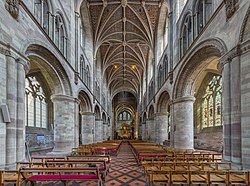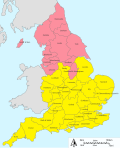Church of England
The Church of England is the leading Christian church in England. It is the church established by law: its formal head is the English monarch (Charles III). It is the mother church of the Anglican Communion. Its headquarters are at Church House, Westminster, in London.
The Church of England understands itself to be both Catholic and Reformed:
- Catholic because it views itself as a part of the universal church of Jesus Christ in unbroken continuity with the early apostolic church. This is expressed in its emphasis on the teachings of the early Church Fathers, as in the Apostles' Creed, Nicene Creed and Athanasian Creed.
- Reformed because it has been shaped by the doctrinal ideas of the 16th-century Protestant Reformation, in particular by the Thirty-Nine Articles and the Book of Common Prayer.
There are other Protestant churches in England which are not part of the Anglican Communion.
History
The Church of England became independent under King Henry VIII in 1534. Henry VIII was married to Catherine of Aragon, but asked the Pope to annul the marriage (say that it was a mistake and that Henry and Catherine were never really married). He wanted to annul the marriage because he wanted a male heir to his throne and Catherine could not produce one. When the annulment was refused, Henry VIII used his position as King to break the Church away from the Roman Catholic Church. This established the independence of the Church of England, sometimes called the Anglican (English) Church. Methodism broke away from the church in the 18th century. The Oxford Movement brought some Catholic beliefs and practices back into the church in the 19th century.
Under his son, King Edward VI, more Protestant forms of worship were adopted. The Archbishop of Canterbury, Thomas Cranmer started more changes. A new pattern of worship was set out in the Book of Common Prayer (1549 and 1552). These were based on the older liturgy but influenced by Protestant principles.
Church Of England Media
Hereford Cathedral is one of the church's 43 cathedrals; many have histories stretching back centuries.
Thomas Cranmer, a Reformer, was the first Protestant Archbishop of Canterbury and principal compiler of the Book of Common Prayer, Thirty-nine Articles, and Books of Homilies.
Captain John Smith's 1624 map of Bermuda, showing St Peter's at centre, left
One of the now "redundant" buildings, Holy Trinity Church, Wensley, in North Yorkshire; much of the current structure was built in the 14th and 15th centuries.
Richard Hooker (1554–1600), one of the most influential figures in shaping Anglican theology and self-identity
Canterbury Cathedral houses the cathedra or episcopal chair of the Archbishop of Canterbury, and is the cathedral of the Diocese of Canterbury and the mother church of the Church of England as well as a focus for the Anglican Communion.
Stained glass window in Rochester Cathedral, Kent
Dioceses of the Church of England Province of Canterbury Province of York
The parish church of St Lawrence in Toot Baldon is typical of many small English village churches.









